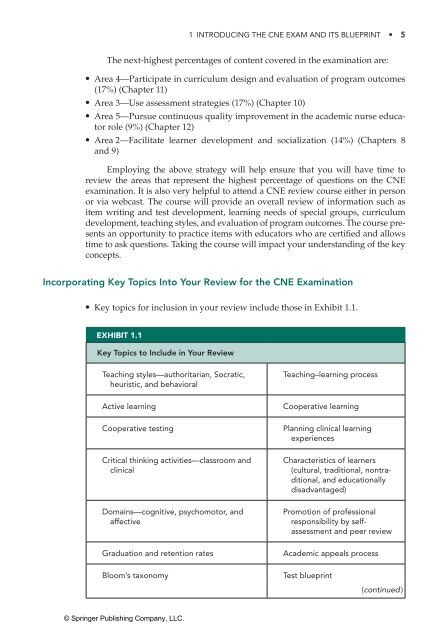Download - Springer Publishing
Download - Springer Publishing
Download - Springer Publishing
You also want an ePaper? Increase the reach of your titles
YUMPU automatically turns print PDFs into web optimized ePapers that Google loves.
1 Introducing the CNE Exam and its Blueprint • 5<br />
The next-highest percentages of content covered in the examination are:<br />
••<br />
Area 4—Participate in curriculum design and evaluation of program outcomes<br />
(17%) (Chapter 11)<br />
• Area 3—Use assessment strategies (17%) (Chapter 10)<br />
• Area 5—Pursue continuous quality improvement in the academic nurse educator<br />
role (9%) (Chapter 12)<br />
••<br />
Area 2—Facilitate learner development and socialization (14%) (Chapters 8<br />
and 9)<br />
Employing the above strategy will help ensure that you will have time to<br />
review the areas that represent the highest percentage of questions on the CNE<br />
examination. It is also very helpful to attend a CNE review course either in person<br />
or via webcast. The course will provide an overall review of information such as<br />
item writing and test development, learning needs of special groups, curriculum<br />
development, teaching styles, and evaluation of program outcomes. The course presents<br />
an opportunity to practice items with educators who are certified and allows<br />
time to ask questions. Taking the course will impact your understanding of the key<br />
concepts.<br />
Incorporating Key Topics Into Your Review for the CNE Examination<br />
••<br />
Key topics for inclusion in your review include those in Exhibit 1.1.<br />
EXHIBIT 1.1<br />
Key Topics to Include in Your Review<br />
Teaching styles—authoritarian, Socratic,<br />
heuristic, and behavioral<br />
Active learning<br />
Cooperative testing<br />
Critical thinking activities—classroom and<br />
clinical<br />
Domains—cognitive, psychomotor, and<br />
affective<br />
Graduation and retention rates<br />
Teaching–learning process<br />
Cooperative learning<br />
Planning clinical learning<br />
experiences<br />
Characteristics of learners<br />
(cultural, traditional, nontraditional,<br />
and educationally<br />
disadvantaged)<br />
Promotion of professional<br />
responsibility by selfassessment<br />
and peer review<br />
Academic appeals process<br />
Bloom’s taxonomy<br />
Test blueprint<br />
(continued )<br />
© <strong>Springer</strong> <strong>Publishing</strong> Company, LLC.

















